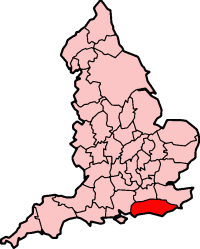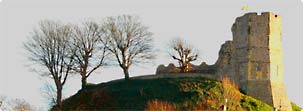|
SUSSEX
|
|||||||||||||||||
|
Sussex is a traditional county in South East England, corresponding roughly in area to the ancient Kingdom of Sussex. It is bounded on the north by Surrey, northeast by Kent, south by the English Channel, and west by Hampshire, and is divided for administrative purposes into West Sussex and East Sussex and the City of Brighton and Hove. The latter was created a unitary authority in 1997; and was granted City status in 2000. Until then Chichester had been Sussex's only city.
The divisions of West Sussex and East Sussex were originally established in 1189, and had obtained separate administrations (Quarter Sessions) by the 16th century. This situation was recognised by the County of Sussex Act 1865. Under the Local Government Act 1888 the two divisions became two administrative counties (along with three county boroughs: Brighton, Eastbourne and Hastings).
The appellation Sussex remained in use as a ceremonial county until 1974, when the Lord-Lieutenant of Sussex was replaced with one each for East and West Sussex. The whole of Sussex has had a single police force since 1968. Sussex still retains a strong local identity and the county's unofficial anthem is Sussex by the Sea. The county's motto, "We wun't be druv", reflects the strong-willed nature of its people in past centuries. Sussex's crest shows six martlets, each of which represents one of the six ancient rapes or sub-divisions of the county.
Geography
Relief
The physical geography of Sussex relies heavily on its lying on the southern part of the Wealden anticline. The major features of that is the high land which crosses the county in a west to east direction: the Weald itself, and the South Downs. The former consists of clays and sands; the latter chalk. Between those two ridges, mainly in West Sussex, lies the ‘’Vale of Sussex’’; at the eastern end of the county is the valley of the River Rother, which flows into what was a long sea inlet to reach the sea at Rye Bay.
The Weald
The Weald runs in an easterly direction from St Leonard’s Forest, south-west of Crawley; and continues to Ashdown Forest. Its eastern extremity is in two sections, divided by the River Rother valley. The northern arm reaches the sea at Folkestone; the southern at Fairlight Down east of Hastings. Within the Weald lies Sussex's highest point, the pine-clad Black Down, close to the Surrey border at 917 ft (280m). Another high point is in the part called Forest Ridges: a height of about 800 ft (240 m) is reached in the neighbourhood of Crowborough.
The High Weald, as the main area is known, gets its name from ’’wilderness’’ or forest, and it remains the highest proportion of ancient woodlands in the country. Around 1660 the total area under forest as estimated to exceed 200,000 acres (800 km²), and supplied the furnaces of the ironworks which formed an important industry in the county down to the 17th century, which survived even until the early years of the 19th.
South Downs
The South Downs start from a point near Petersfield in Hampshire . Entering Sussex, its summit is about 10 miles (16 km) from the sea. They run east for some 50 miles (80 km), gradually approaching the coast, and terminating in the bold promontory of Beachy Head near Eastbourne. The average height is about 500 ft (150 m), though Ditchling Beacon is 813 ft (248 m) (the third highest summit) and many other summits exceed 700 ft (210 m).
Dry valleys are a feature of the Downs. One in particular, known as Devil's Dyke, north-west of Brighton, is a popular tourist and outdoor sports venue.
Vale of Sussex
The Vale of Sussex is the lower undulating land which came into being when the softer clays between the Weald and the Downs were worn away. Crossing the Vale are most of the rivers in Sussex: those rising on the slopes of the Weald and cutting through the Downs to reach the sea (see Drainage).
The coastal plain
This is a fertile narrow belt from Chichester to Brighton. Once noted for market gardening, it is now heavily built-up into a sprawling coastal conurbation. The beaches along the coast vary from sandy to shingle: that factor, together with the mild climate of the coast, sheltered by the hills from north and east winds, have resulted in the growth of numerous resort towns, of which the most popular are Brighton, Hastings, Eastbourne, Bexhill, Seaford, Shoreham-by-Sea, Worthing, Littlehampton and Bognor.
Marshland
There are several areas of low-lying marshland along the coast; from west to east these are:
All were originally bays; natural coastal deposition and man-made protective walls have given rise to alluvial deposition.
Drainage
The rivers wholly within the county are relatively short. All rise in the Weald (St Leonard’s Forest area) and, apart from the eastern River Rother, flow south to the English Channel, using gaps in the South Downs as they do so. The mouths of all have been affected by longshore drift, particularly during violent storms during the Middle Ages. From west to east they are:
Climate
South East England combines the highest average daytime temperatures found in the British Isles with the highest sunshine averages on the British mainland. Between 25-30 inches (635-760mm) of rain fall; and there can be high variation of temperature between day and night, resulting in bracing air.
The climate of the coast district is strongly influenced by the sea, which because of its tendency to warm up slower than land, can result in cooler temperatures than inland. This is especially noticeable in the autumn months, by which time the coast had higher temperatures. Rainfall during the summer months is mainly from thunderstorms and thundery showers; from October to January the heavier rainfall is due to south-westerly frontal systems. the coast has consistently more sunshine the inland: sea breezes, blowing off the sea, clear any cloud from the coast.
Agriculture
Sussex has retained much of its rural nature: apart from the coastal strip, there it has few large towns. Although in 1841 over 40% of the population were employed in agriculture (including fishing}, today less than 2% are so employed. There are still fishing fleets, notably at Rye and Hastings, but the number of boats is much reduced.
Historically, the fisheries were of great importance, including cod, herring, mackerel, sprats, plaice, soles, turbot, shrimps, crabs, lobsters, oysters, mussels, cockles, whelks and periwinkles. Bede records that St Wilfrid, when he visited the county in 681, taught the people the art of netfishing. At the time of the Domesday survey the fisheries were extensive, and no fewer than 285 salinae (saltworks) existed. The customs of the Brighton fishermen were documented in 1579.
There are working harbours at Rye, Hastings, Newhaven and Shoreham; whilst Pagham and Chichester Harbours cater for leisure craft.
Iron working
In medieval times the Weald was of national importance in the iron industry, and the remains of that industry are still to be seen in the form of Furnace ponds.
Service industries
The string of holiday resorts, and the many tourist attractions, form part of the main economic base in Sussex. The presence of the University of Sussex at Brighton provides employment for many more; whilst reasonable rail connections allow many people to work in London.
"Borough English"
The custom of borough-English, by which land descends to the youngest son, prevailed to an extraordinary degree in Sussex, and no fewer than 140 manors have been catalogued in which it was found. Gavelkind tenure existed in Rye, in the large manor of Brede, and in Coustard manor (in Brede parish).
Population
The area of the ancient county is 933,887 acres (3,800 km²), with a population in 1891 of 550,446 and in 1901 of 605,202. The earliest statement as to the population is made by Bede, who describes the county as containing in the year 681 land of 7000 families; allowing ten to a family (not an unreasonable estimate at that date), the total population would be 70,000.
In 1693 the county is stated to have contained 21,537 houses. If seven were allowed to a house at that date, the total population would be 150,759. It is curious, therefore, to observe that in 1801 the population was only 159,311. The decline of the Sussex ironworks probably accounts for the small increase of population during several centuries, although after the massacre of St Bartholomew upwards of 1500 Huguenots landed at Rye, and in 1685, after the revocation of the Edict of Nantes, many more refugees were added to the county.
An act of Henry VII (1504) directed that for convenience the county court should be held at Lewes as well as at Chichester, and this apparently gave rise to the division of Sussex into east and west parts.
SUSSEX PAST | EVENTS | RESEARCH | PROPERTIES | EDUCATION | MEMBERSHIP | WEDDINGS | SHOP
SUSSEX INDEX A - Z
CHIDDINGLY - HORSE SHOW and GYMKHANA CUCKMERE VALLEY - EXCEAT HERSTMONCEUX - MUSEUM - COSTS SCANDAL - PARISH COUNCIL - 70 HOUSES - RAF PEVENSEY CASTLE - & CUCKMERE WATER LEVEL MANAGEMENT BOARD TWISSELLS MILL, OLD HEATHFIELD Solar Cola - a healthier alternative
|



